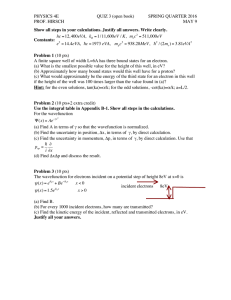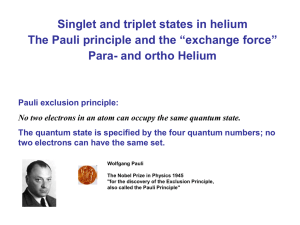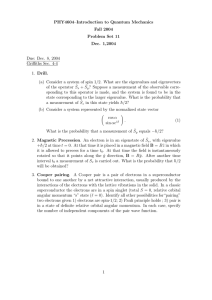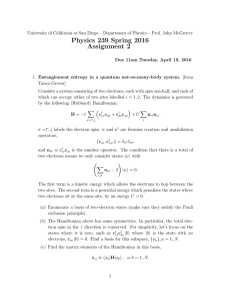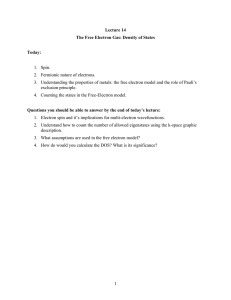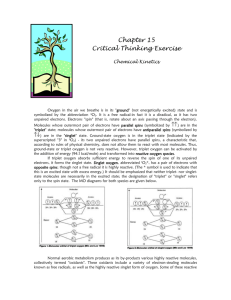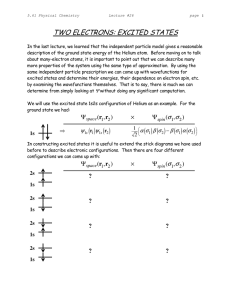MASSACHUSETTS INSTITUTE OF TECHNOLOGY Physics Department 8.044 Statistical Physics I Spring Term 2013
advertisement
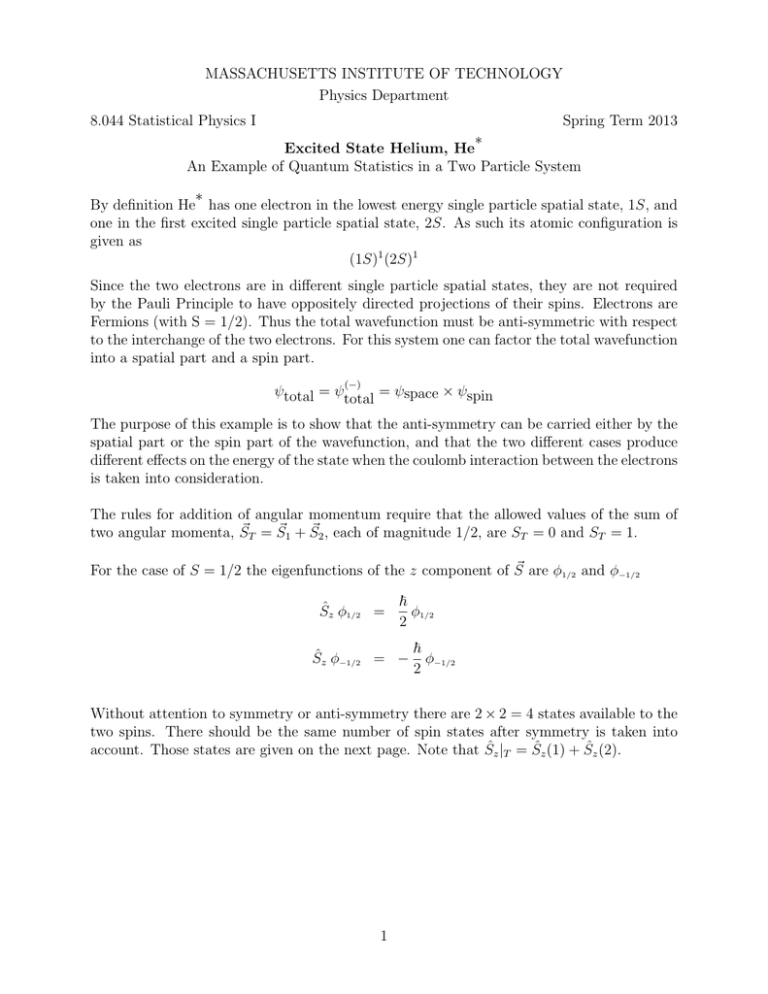
MASSACHUSETTS INSTITUTE OF TECHNOLOGY Physics Department 8.044 Statistical Physics I Spring Term 2013 ∗ Excited State Helium, He An Example of Quantum Statistics in a Two Particle System ∗ By definition He has one electron in the lowest energy single particle spatial state, 1S, and one in the first excited single particle spatial state, 2S. As such its atomic configuration is given as (1S)1 (2S)1 Since the two electrons are in different single particle spatial states, they are not required by the Pauli Principle to have oppositely directed projections of their spins. Electrons are Fermions (with S = 1/2). Thus the total wavefunction must be anti-symmetric with respect to the interchange of the two electrons. For this system one can factor the total wavefunction into a spatial part and a spin part. ψtotal = ψ (−) total = ψspace × ψspin The purpose of this example is to show that the anti-symmetry can be carried either by the spatial part or the spin part of the wavefunction, and that the two different cases produce different effects on the energy of the state when the coulomb interaction between the electrons is taken into consideration. The rules for addition of angular momentum require that the allowed values of the sum of ~T = S ~1 + S ~2 , each of magnitude 1/2, are ST = 0 and ST = 1. two angular momenta, S ~ are φ1/2 and φ−1/2 For the case of S = 1/2 the eigenfunctions of the z component of S ~ φ1/2 Sˆz φ1/2 = 2 ~ Sˆz φ−1/2 = − φ−1/2 2 Without attention to symmetry or anti-symmetry there are 2 × 2 = 4 states available to the two spins. There should be the same number of spin states after symmetry is taken into account. Those states are given on the next page. Note that Sˆz |T = Sˆz (1) + Sˆz (2). 1 1 √ ψspin: 0,0 = φ1/2 (1)φ−1/2 (2) − φ1/2 (2)φ−1/2 (1) 2 (−) For this state, (−) ŜT2 ψspin: 0,0 = 0 (−) Ŝz |T ψspin: 0,0 = 0 (−) (−) Pˆ1,2 ψspin: 0,0 = − ψspin: 0,0 It is called a singlet state. (+) ψspin: 1, 1 = φ1/2 (1)φ1/2 (2) 1 ψspin: 1,0 = √ φ1/2 (1)φ−1/2 (2) + φ1/2 (2)φ−1/2 (1) 2 (+) (+) ψspin: 1, −1 = φ−1/2 (1)φ−1/2 (2) For these states (+) (+) SˆT2 ψspin: 1, m = 2~2 ψspin: 1, m s s (+) (+) Sˆz |T ψspin: 1, m = ms ~ ψspin: 1, m s s (+) (+) Pˆ1,2 ψspin: 1, m = + ψspin: 1, m s s These three states are collectively called the triplet state. 2 So much for the spin part of the wave function. Now we have to create symmetric and anti-symmetric spatial states. This is simpler since we only have two single particle states ∗ to work with and we can not use either one more than once by the definition of He . Two states in; two states out. 1 (+) ψspace = √ ψ1S (1)ψ2S (2) + ψ1S (2)ψ2S (1) 2 1 (−) ψspace = √ ψ1S (1)ψ2S (2) − ψ1S (2)ψ2S (1) 2 Now we can combine the spin and spatial parts to create the total wavefunction, which ∗ remember must be anti-symmetric. For singlet He the anti-symmetry is carried out by the spin part of the wavefunction. There is only one way of doing that. 1 1 (−) ψ = √ ψ1S (1)ψ2S (2) + ψ1S (2)ψ2S (1) × √ φ1/2 (1)φ−1/2 (2) − φ1/2 (2)φ−1/2 (1) total 2 2 ∗ For triplet He the anti-symmetry is carried out by the spatial part of the wavefunction. There are ways of accomplishing that. 1 √ ψ1S (1)ψ2S (2) − ψ1S (2)ψ2S (1) × φ1/2 (1)φ1/2 (2) 2 1 1 √ ψ1S (1)ψ2S (2) − ψ1S (2)ψ2S (1) × √ (φ1/2 (1)φ−1/2 (2) + φ1/2 (2)φ−1/2 (1) 2 2 1 √ ψ1S (1)ψ2S (2) − ψ1S (2)ψ2S (1) × φ−1/2 (1)φ−1/2 (2) 2 As expected, we end up with a total of 4 two-particle states, one singlet state and three triplet states. Is there some physical consequence that can be ascribed to the structure of these states? Yes there is. We have been neglecting the coulomb interaction between the two electrons. Taking this into account is a difficult problem, and at best the four wavefunctions we have developed will be just some of the non-interacting two-body states that might be combined to approximate the true two-body wavefunctions of an excited state of atomic helium. All the true energy levels will go up because the interaction between the electrons is repulsive. The electrons will be less bound. But imagine that we made a first stab at approximating the increase in the energy by evaluating the coulomb energy of the electron cloud produced by taking the charge distribution resulting from our wavefunctions. The greatest contributions would come from spots where the two electrons were closest together. In the triplet case the wavefunction goes to zero when the two electrons approach each other. 3 In the singlet case the two electrons may approach each other and even overlap. Thus the triplet state should have a lower energy when the electron-electron interaction is taken into account. It will still be higher than the non-interacting situation, but not as high as the singlet case. In the real helium atom one does find excited energy levels that can be identified experimentally by their total spin. The triplet state, that with S=1, does indeed lie lower (farther below the continuum) than the singlet state where S=0. 4 MIT OpenCourseWare http://ocw.mit.edu 8.044 Statistical Physics I Spring 2013 For information about citing these materials or our Terms of Use, visit: http://ocw.mit.edu/terms.
